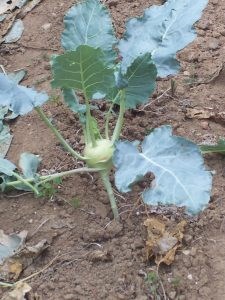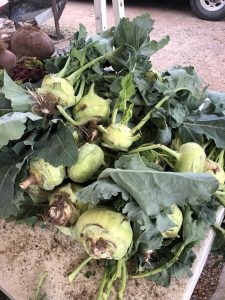This content was originally published by the Longmont Observer and is licensed under a Creative Commons license.
The cool weather signals a shift at the Saturday Longmont farmers market. Gone are the peaches and plums. There was still some corn last week and peppers are raging, sensing their imminent demise at the first frost. The fall crops are ascending—pumpkins and gourds, root vegetables of every description as well as that conundrum of a vegetable, the kohlrabi, that looks like a root but isn’t.

The mention of kohlrabi sparks reminiscence in many who hear the word, who recall fresh from the garden encounters with the vegetable and a salt shaker, no doubt the best way to get to know the vegetable. At the Augustiner Brewery in Salzburg, kohlrabi are cut into lacy ribbons to order, salted, and served as a snack with the beer. Longmont breweries, take note; this is a health food that marries well with your “golden liquid bread.”
Kohlrabi, Brassica oleracea, is a member of the exuberant cabbage family that manifests itself in many interesting ways. These cruciferous vegetables, a term that relates to the cross-like shape of the emerging seedling, come in a multitude of shapes and sizes. There are the long, wide, crinkled leaves of Chinese cabbage; the large, smooth rounded heads of the typical cabbage plant; the tight, miniature heads of Brussels sprouts which are actually the leaves of the plant; the green buds on a fleshy stalk of broccoli and the compressed white flower head of cauliflower. Kohlrabi is actually a bulbous plant stem and is at its best when harvested when young and tender, with a diameter of less than 3 inches. Cruciferous vegetables contain a class of nutrients called isothiocyanates that are proven cancer fighters, so they are excellent to include in the diet.
The term “kohlrabi” is a combination of the German words “”kohl” for cabbage and “rabi” for turnip. The crisp, sweet flesh of the plant is very mild, reminiscent of broccoli stem, but sweeter, like an Asian pear. The leaves of the plant are also edible, raw in salads or cooked like spinach.
The origins of the plant are disputed, with some plant historians dating it to the Roman Empire through descriptions in Pliny the Elder’s writings of a “Corinthian turnip” and actual recipes in Apicius’ cookbook, the first in Western culture, that mention the vegetable. Charlemagne, who ruled the Roman Empire around 800 AD, ordered kohlrabi planted in his lands in western Germany, and the name given to it at that time endures. Another branch of plant historians maintains that it developed from the wild mallow cabbage in Europe in the 16th century, about the time that it worked its way east to India.
Whatever its origin, the plant offers a wealth of nutrients in its unassuming guise. It is very low in calories, at about 19 for a half cup of the vegetable. It is high in fiber, potassium, copper, manganese, iron, calcium and provides vitamins A and K. It has as much vitamin C as a similarly sized orange, which does not pair well with beer. The plant comes in green and purple varieties and is both ornamental in the garden and easy to grow.

Kohlrabi is in common use throughout Italy, France, Germany and Asia and is popular in the Southern United States, where the leaves are used as a pot green. The rest of the US hasn’t quite caught on yet, except in Duluth, Minnesota where it was named the 2018 vegetable of the year last January.
Locally, look for this vegetable at area farmers markets and enjoy this delicacy at the height of its season—right now. Most kohlrabi enthusiasts enjoy it very simply—peeled, sliced and with a sprinkling of salt. Or try this German-style salad preparation method.
Kohlrabi Salad with Mustard Vinaigrette
Makes 4-6 servings
One pound kohlrabi
Peel kohlrabi grate or cut into fine julienne strips and toss with enough Mustard Vinaigrette to moisten.
Mustard Vinaigrette
- 2 tablespoons red wine vinegar, sherry vinegar, or fresh lemon juice
- 1shallot, minced
- 1 clove garlic, minced
- Salt and pepper
- 1 tablespoon Dijon mustard
- 2 tablespoons 0% fat plain Greek yogurt
- 1/3 cup extra virgin olive oil
- 1 tablespoon snipped chives
- 1 tablespoon chopped parsley
- 1 tablespoon capers, rinsed
Combine the vinegar, shallots, garlic, and 1/4 t. salt in a small bowl and let rest for 10 minutes. Whisk in the mustard, yogurt, and oil until thick and smooth. Grind in a little pepper, then stir in the herbs and capers. Taste and adjust the seasonings if needed.


